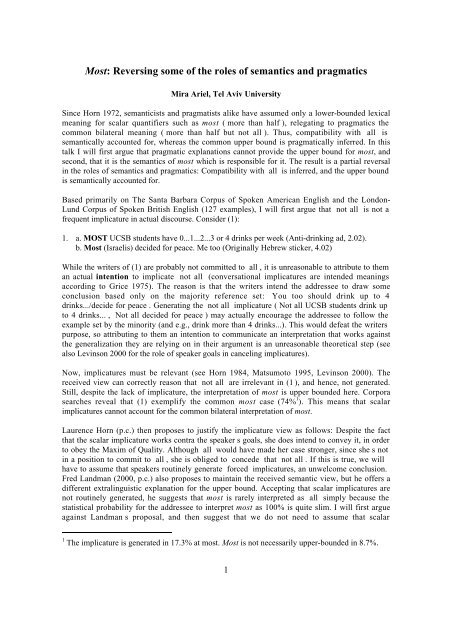SemPrag03.Progr.pdf - Institut für Linguistik/Germanistik - Universität ...
SemPrag03.Progr.pdf - Institut für Linguistik/Germanistik - Universität ...
SemPrag03.Progr.pdf - Institut für Linguistik/Germanistik - Universität ...
You also want an ePaper? Increase the reach of your titles
YUMPU automatically turns print PDFs into web optimized ePapers that Google loves.
Most: Reversing some of the roles of semantics and pragmatics<br />
Mira Ariel, Tel Aviv University<br />
Since Horn 1972, semanticists and pragmatists alike have assumed only a lower-bounded lexical<br />
meaning for scalar quantifiers such as most ( more than half ), relegating to pragmatics the<br />
common bilateral meaning ( more than half but not all ). Thus, compatibility with all is<br />
semantically accounted for, whereas the common upper bound is pragmatically inferred. In this<br />
talk I will first argue that pragmatic explanations cannot provide the upper bound for most, and<br />
second, that it is the semantics of most which is responsible for it. The result is a partial reversal<br />
in the roles of semantics and pragmatics: Compatibility with all is inferred, and the upper bound<br />
is semantically accounted for.<br />
Based primarily on The Santa Barbara Corpus of Spoken American English and the London-<br />
Lund Corpus of Spoken British English (127 examples), I will first argue that not all is not a<br />
frequent implicature in actual discourse. Consider (1):<br />
1. a. MOST UCSB students have 0...1...2...3 or 4 drinks per week (Anti-drinking ad, 2.02).<br />
b. Most (Israelis) decided for peace. Me too (Originally Hebrew sticker, 4.02)<br />
While the writers of (1) are probably not committed to all , it is unreasonable to attribute to them<br />
an actual intention to implicate not all (conversational implicatures are intended meanings<br />
according to Grice 1975). The reason is that the writers intend the addressee to draw some<br />
conclusion based only on the majority reference set: You too should drink up to 4<br />
drinks.../decide for peace . Generating the not all implicature ( Not all UCSB students drink up<br />
to 4 drinks... , Not all decided for peace ) may actually encourage the addressee to follow the<br />
example set by the minority (and e.g., drink more than 4 drinks...). This would defeat the writers<br />
purpose, so attributing to them an intention to communicate an interpretation that works against<br />
the generalization they are relying on in their argument is an unreasonable theoretical step (see<br />
also Levinson 2000 for the role of speaker goals in canceling implicatures).<br />
Now, implicatures must be relevant (see Horn 1984, Matsumoto 1995, Levinson 2000). The<br />
received view can correctly reason that not all are irrelevant in (1 ), and hence, not generated.<br />
Still, despite the lack of implicature, the interpretation of most is upper bounded here. Corpora<br />
searches reveal that (1) exemplify the common most case (74% 1 ). This means that scalar<br />
implicatures cannot account for the common bilateral interpretation of most.<br />
Laurence Horn (p.c.) then proposes to justify the implicature view as follows: Despite the fact<br />
that the scalar implicature works contra the speaker s goals, she does intend to convey it, in order<br />
to obey the Maxim of Quality. Although all would have made her case stronger, since she s not<br />
in a position to commit to all , she is obliged to concede that not all . If this is true, we will<br />
have to assume that speakers routinely generate forced implicatures, an unwelcome conclusion.<br />
Fred Landman (2000, p.c.) also proposes to maintain the received semantic view, but he offers a<br />
different extralinguistic explanation for the upper bound. Accepting that scalar implicatures are<br />
not routinely generated, he suggests that most is rarely interpreted as all simply because the<br />
statistical probability for the addressee to interpret most as 100% is quite slim. I will first argue<br />
against Landman s proposal, and then suggest that we do not need to assume that scalar<br />
1 The implicature is generated in 17.3% at most. Most is not necessarily upper-bounded in 8.7%.<br />
1

















